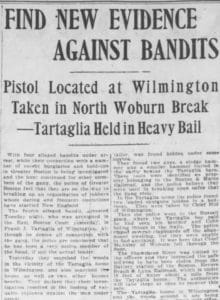 One hundred years ago, Chief Walter Hill and his police officers found themselves in the grips of a crime wave that was running rampant over much of the area. Given the year, the reader might initially surmise a bootlegging story is to follow but that is not the case. While the anti-liquor and the local gin mill industry will eventually be told, this instead will tell of the story of the Tartaglia Gang. Often dominating the newspaper headlines throughout much of 1922, the gang’s criminal exploits included burglaries, robberies, car theft and safe breaking. While keeping on the down low was their preferred practice, they were certainly not afraid to throw down when confronted by the authorities. Their hideouts were in East Boston and on a remote farm in rural Wilmington. They were referred to in the press as “yeggs” or a “yegg gang,” period slang for robbers and safe breakers.
One hundred years ago, Chief Walter Hill and his police officers found themselves in the grips of a crime wave that was running rampant over much of the area. Given the year, the reader might initially surmise a bootlegging story is to follow but that is not the case. While the anti-liquor and the local gin mill industry will eventually be told, this instead will tell of the story of the Tartaglia Gang. Often dominating the newspaper headlines throughout much of 1922, the gang’s criminal exploits included burglaries, robberies, car theft and safe breaking. While keeping on the down low was their preferred practice, they were certainly not afraid to throw down when confronted by the authorities. Their hideouts were in East Boston and on a remote farm in rural Wilmington. They were referred to in the press as “yeggs” or a “yegg gang,” period slang for robbers and safe breakers.
This brazen band, led by eighteen-year-old Frank Tartaglia, operated throughout Boston and across several communities both north and south of the city. However, despite their leader’s teen years, they were not ordinary, petty larceny thieves. Their scores were meticulously planned and almost never failed to produce lucrative takes of monies, jewels, furs, clothing, guns, cars and just about anything that could be stashed in a safe. They were also not deterred by those locked strongboxes and vaults within such valuables were held. Those temporary obstacles were merely an inconvenience. To help themselves on their way to riches they first planned and conducted breaks into local railyards and train depots. Their specialty there was to seize heavy track and railroad tools. Spike mauls, picks, sledgehammers, block and tackle setups, track benders, spike pullers, crow bars and rail drills all went missing from local railroad maintenance sheds. Next up following the railroad thefts came the cased-out stores and factories of the many surrounding cities and towns. Payrolls, cash, coins, jewels and bonds were always a given to be hidden away in such receptacles. If a safe was light enough, it was carried away. If it was too heavy to be moved, it was cracked in place. Swinging their stolen hammers and mauls, hinge pins were broken and popped. Spike pullers and track benders tore out locksets and combination wheels. Crowbars and pickaxes peeled doors too flimsy to withstand such an attack.
In April of 1922, the Winchester train station agent was shot and killed in the depot ticket office. Hit once in the chest and once in the face by close range shots from a .32 caliber pistol it was believed that he may have been the victim of the Tartaglia Gang casing the railroad for tools. While his murder remains unsolved, it was a .32 caliber handgun recovered in a Wilmington Police raid of a camp near Silver Lake that initially shone the light on the Tartaglia Gang.
A later police raid on the Tartaglia farmhouse in May saw Wilmington and Boston officers in a knockdown, drag out fight with the gangsters. After breaking a jewelry store safe in Somerville, the gang returned to their Wilmington hideout unknowingly having been followed by Boston Police. As darkness fell a Boston sergeant and two police officers accompanied Wilmington Special Officer Jerome O’Leary on a raid at the Tartaglia farmhouse. As described in newspaper accounts, the officers engaged in a fierce, hand to hand struggle with the gang during which two of the members escaped by diving out of windows and fleeing into the darkness. Recovered from the raid was jewelry and two shotguns. Located on the outskirts of town, the farmhouse was the late 1600s era Peter Cornell House built when this section of town was still part of Billerica. Situated on a twenty-five-acre parcel of land on the corner of Shawsheen Avenue and Hopkins Street, the farm was owned by Frank Tartaglia’s mother and father. The Shawsheen School now occupies the land where this rural hideout once stood.
So elusive and prolific were the gang’s crimes that the new state police force, formed just a year before in 1921, was ordered to establish a substation in Wilmington. Quartered at the West Schoolhouse on Shawsheen Avenue just a mile from the Tartaglia farm, the State Police Patrol worked hand in hand with Wilmington and other police departments in surveilling and pursuing the gang. On several occasions investigators searched for evidence in Wilmington looking for the fruits of their criminal endeavors. In one instance, a 300-pound safe was recovered from the Shawsheen River not far from the Tartaglia farm. On another occasion, an abandoned farmhouse nearby the Tartaglia property was searched by Chief Hill and officers from surrounding towns, turning up more guns.
Throughout the year, Wilmington, Woburn, Winchester, Boston, Railroad and State Police Patrol officers and detectives worked the cases doggedly. The two yeggs that escaped the clutches of Officer Jerome O’Leary in May were eventually caught in East Boston as the gang met near the Boston & Albany railyard, presumably to score more tools. After the arrests were made, indictments were quickly handed down. The six gang members eventually pleaded guilty to the crimes charged thus ending their string of robberies. Frank Tartaglia was sentenced to 4-6 years in the State Prison. The State Police Patrol moved on from their Wilmington substation in 1924 and the Tartaglia’s lost their farm to foreclosure in 1927.
After his release from prison, Frank Tartaglia continued with his life of crime. In March of 1936 he was suspected of a robbery at Chelsea City Hall that netted $16,000. In June of that year, Frank Tartaglia was one of a gang of four bandits that attempted to rob an armored car at the Boston & Maine depot in downtown Lawrence, Massachusetts. A gun battle ensued between the gang and armored car’s driver and guard. In the end, Frank Tartaglia and another gang member were mortally wounded in a hail of gunfire. In 1968, the land on which the Tartaglia Gang laid low and hid their loot throughout 1922 was acquired by the town for a proposed school. In 1970, the recently opened Shawsheen School welcomed its first students.
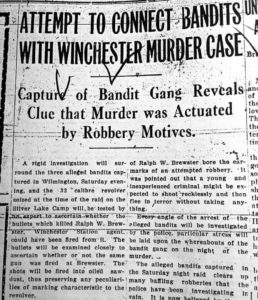
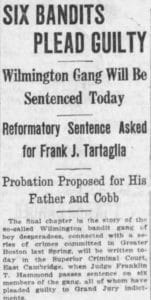
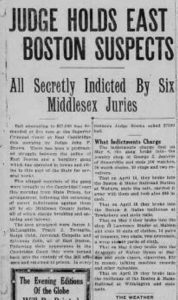


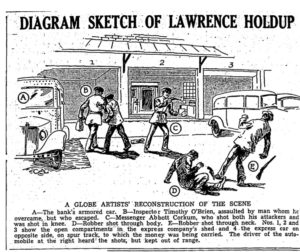
Comments are closed.